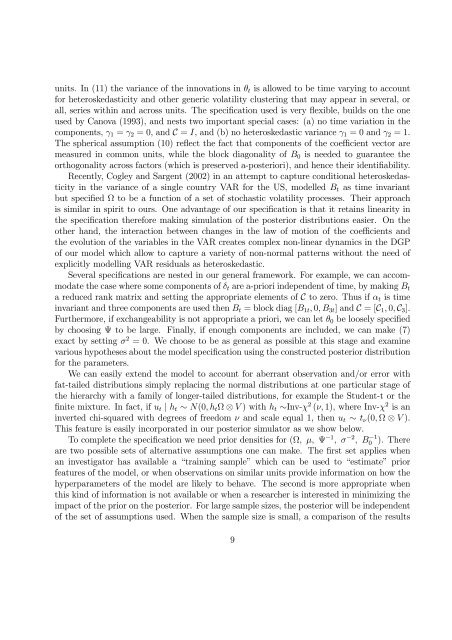PANEL INDEX VAR MODELS: SPECIFICATION, ESTIMATION - Ivie
Create successful ePaper yourself
Turn your PDF publications into a flip-book with our unique Google optimized e-Paper software.
units. In (11) the variance of the innovations in θ t is allowed to be time varying to account<br />
for heteroskedasticity and other generic volatility clustering that may appear in several, or<br />
all, series within and across units. The specification used is very flexible, builds on the one<br />
used by Canova (1993), and nests two important special cases: (a) no time variation in the<br />
components, γ 1 = γ 2 =0,andC = I, and (b) no heteroskedastic variance γ 1 =0andγ 2 =1.<br />
The spherical assumption (10) reflect the fact that components of the coefficient vector are<br />
measured in common units, while the block diagonality of B 0 is needed to guarantee the<br />
orthogonality across factors (which is preserved a-posteriori), and hence their identifiability.<br />
Recently, Cogley and Sargent (2002) in an attempt to capture conditional heteroskedasticity<br />
in the variance of a single country <strong>VAR</strong> for the US, modelled B t as time invariant<br />
but specified Ω to be a function of a set of stochastic volatility processes. Their approach<br />
is similar in spirit to ours. One advantage of our specification is that it retains linearity in<br />
the specification therefore making simulation of the posterior distributions easier. On the<br />
other hand, the interaction between changes in the law of motion of the coefficients and<br />
the evolution of the variables in the <strong>VAR</strong> creates complex non-linear dynamics in the DGP<br />
of our model which allow to capture a variety of non-normal patterns without the need of<br />
explicitly modelling <strong>VAR</strong> residuals as heteroskedastic.<br />
Several specifications are nested in our general framework. For example, we can accommodate<br />
the case where some components of δ t are a-priori independent of time, by making B t<br />
a reduced rank matrix and setting the appropriate elements of C to zero. Thus if α t is time<br />
invariant and three components are used then B t =blockdiag[B 1t , 0,B 3t ]andC =[C 1 , 0, C 3 ].<br />
Furthermore, if exchangeability is not appropriate a priori, we can let θ 0 be loosely specified<br />
by choosing Ψ to be large. Finally, if enough components are included, we can make (7)<br />
exact by setting σ 2 =0. Wechoosetobeasgeneralaspossibleatthisstageandexamine<br />
various hypotheses about the model specification using the constructed posterior distribution<br />
for the parameters.<br />
We can easily extend the model to account for aberrant observation and/or error with<br />
fat-tailed distributions simply replacing the normal distributions at one particular stage of<br />
the hierarchy with a family of longer-tailed distributions, for example the Student-t or the<br />
finite mixture. In fact, if u t | h t ∼ N(0,h t Ω ⊗ V )withh t ∼Inv-χ 2 (ν, 1), where Inv-χ 2 is an<br />
inverted chi-squared with degrees of freedom ν and scale equal 1, then u t ∼ t ν (0, Ω ⊗ V ).<br />
This feature is easily incorporated in our posterior simulator as we show below.<br />
To complete the specification we need prior densities for (Ω, µ,Ψ −1 , σ −2 ,B0 −1 ). There<br />
are two possible sets of alternative assumptions one can make. The first set applies when<br />
an investigator has available a “training sample” which can be used to “estimate” prior<br />
features of the model, or when observations on similar units provide information on how the<br />
hyperparameters of the model are likely to behave. The second is more appropriate when<br />
this kind of information is not available or when a researcher is interested in minimizing the<br />
impact of the prior on the posterior. For large sample sizes, the posterior will be independent<br />
of the set of assumptions used. When the sample size is small, a comparison of the results<br />
9

















